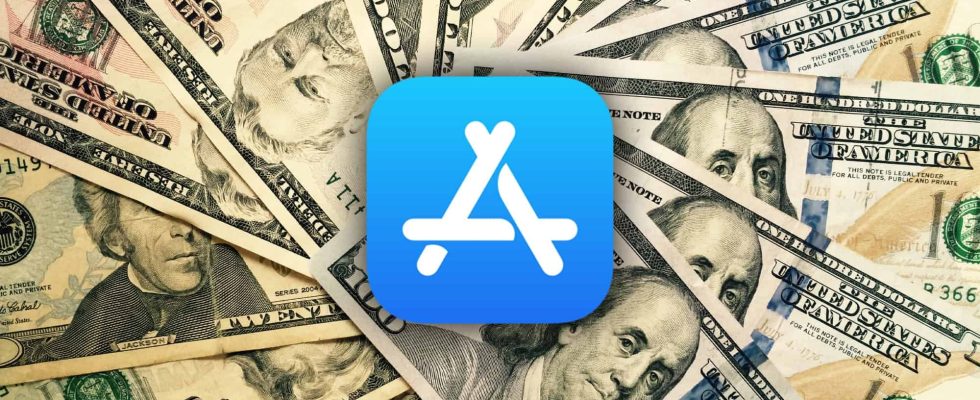Apple continues to monetize app developers. TechInside has announced that the App Store ecosystem has brokered $1.1 trillion in sales to developers in 2022. The App Store continues to create an increasing number of opportunities for developers around the world. It’s also interesting that more than 90 percent of this revenue was received only by developers and businesses, without paying any commission to Apple.
Different options to monetize the App Store ecosystem
Developers on the App Store have more opportunities than ever to monetize their apps and build successful businesses. Analysis Group economists estimate that App Store developers earned $910 billion from sales of physical products and services, $109 billion from app ads, and $104 billion from digital products and services last year.
“The incredible developer community around the world gives us more hope and inspiration all the time,” says Tim Cook, Apple’s CEO. “As this report demonstrates, the App Store is a vibrant and innovative marketplace where opportunities thrive, and we are as committed as ever to investing in developer success and the future of the app economy.”
Key factors behind growth
Analysis Group research takes a closer look at the key drivers behind growth in the App Store ecosystem, including the recovery in demand for industries like travel and ride-hailing, and strong growth in ad spend in apps like social media and retail apps.
Developer sales 27% between 2019 and 2020; 27 percent between 2020 and 2021; Between 2021 and 2022, it increased by 29%. Small developers in particular have had tremendous success on the App Store, increasing their revenue by 71 percent between 2020 and 2022, outpacing the big developers. Economists at Analysis Group believe such growth rates are positive indicators and consistent with a thriving market full of dynamism, innovation and competition.
App Store is a global distribution platform
The App Store provides Apple developers around the world with a global distribution platform that supports more than 195 local payment methods and 44 currencies across 175 different stores. It also enabled developers to reach users across borders: In 2022, 54 percent of downloads occurred in stores outside the developers’ home country. According to new data from Apple, the App Store attracted more than 650 million average weekly visitors worldwide in 2022. And users downloaded an average of more than 747 million new apps and 1.5 billion reapps each week, respectively, in 2022.
Strong growth in different app categories
The new study, titled “The Continued Growth and Resilience of Apple’s App Store Ecosystem,” published earlier today by Analysis Group economists, draws on a wide range of economic data that point to developers’ growth in the App Store. The study reveals that activity increased in different categories after developers’ billing and sales facilitated by the App Store.
For example, as restrictions ease in many parts of the world, demand in app categories such as travel and ride-hailing has rebounded significantly. While travel sales made through iOS applications increased by 84 percent in 2022, there was a 45 percent increase in the sales of ride-hailing applications.
Food and grocery sales were also among the fastest growing app categories. Since 2019, iOS app-based meal delivery and pickup sales have more than doubled, and grocery sales more than tripled. In addition, enterprise apps have grown in popularity among companies around the world over the past few years. These apps represent one of the fastest growing categories of digital goods and services in Analysis Group’s invoicing and sales forecasting in 2022. The highest growth in digital products and services is seen in the app-based entertainment category due to the emergence of important trends such as the creative economy in recent years and the prominence of applications supporting this field.
App Store 15 years old
Fifteen years since its launch in 2008, the App Store has consistently offered more opportunities to developers and more apps to Apple users that enrich their lives. The driving force behind this success is Apple’s continued investment in the future of the app economy. Offering a secure and reliable marketplace for users and powerful tools to help developers make great apps, the App Store creates an incredible economic opportunity for global app creators.
In total, iOS developers made more than $320 billion from the App Store from 2008 to 2022. Analysis Group research revealed that iOS users downloaded apps more than 370 billion times from 2008 to 2022. And there are more than 123 times (about 1.8 million) apps in the App Store today, compared to the thousands of apps available at the end of 2008.
Today’s developers also include in-app purchases and subscriptions; They have more options to monetize their business, including more developer tools, including 40+ SDKs and 250,000 APIs, and educational resources like Apple’s Developer Academies, Entrepreneur Camp, and other programs that teach coding and business development skills.
The App Store’s technologies and services support a wide variety of app businesses, including developers selling physical products and services. This includes integration with Apple Pay, biometric authentication with Face ID and Touch ID, account security, and other technologies that help developers securely connect with Apple users.
The App Store has also remained a safe and reliable marketplace for users, thanks to Apple’s rigorous App Review process and robust privacy and security protections. The App Store blocked more than $2 billion in fraudulent transactions in 2022 and rejected 1.7 million app submissions for not meeting privacy, security, and quality standards. Recent innovations such as App Tracking Transparency and Privacy Labels allow users to know even more about how their apps use their data.

